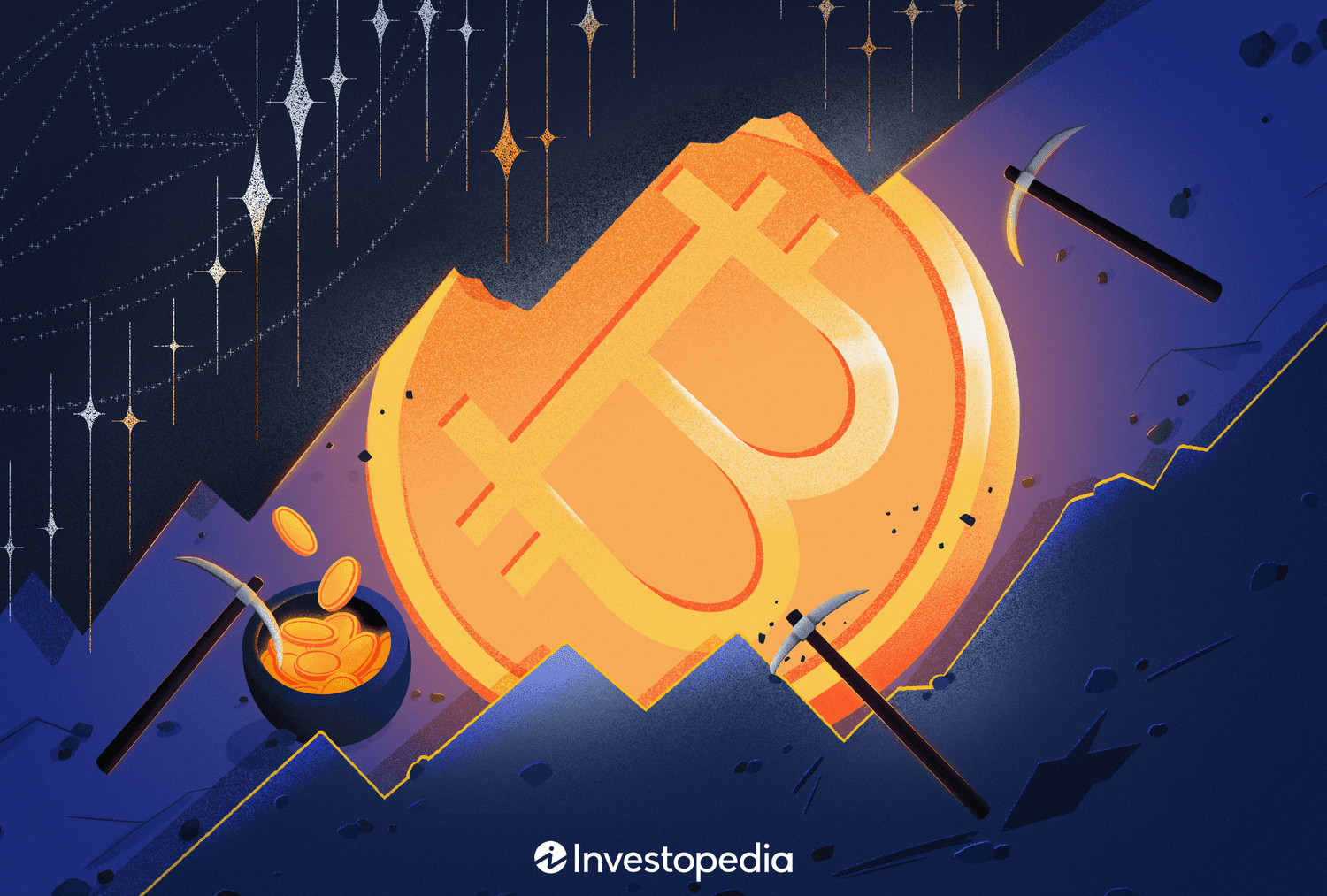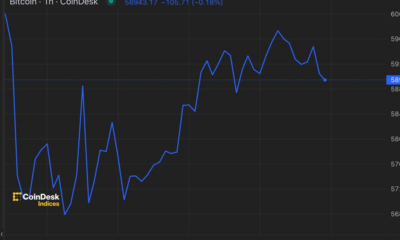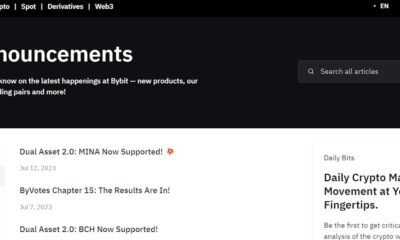News
This Bitcoin Halving Is Different. But Is It ‘Priced In’?

This year’s halving — the quadrennial slashing of the amount of new bitcoin (BTC) entering into circulation — may be the most important since the first one around 12 years ago. And yet, despite intense interest in the event, its price impact may be more muted this year than previous halvings. Recently launched protocols, like Ordinals, and an increasingly robust mining sector, mean the effect could be relatively soft.
The Bitcoin halving, expected to take place late Friday night or early Saturday (April 20), comes with heightened expectations. In each previous case so far, the halving preceded massive sector-wide rallies. There is an ongoing debate whether the halving is “priced in,” or whether the reduced amount of bitcoin entering into circulation (this time dropping from around 900 BTC per day to 450 BTC) will create a kind of supply shock that will drive prices up (assuming demand for bitcoin remains constant or increases).
There are two economic theories that explain this debate. On one side are those who believe the halving is priced in believe the efficient market theory. They say because the event is known in advance, and everyone shares the same information, it is impossible that bitcoin is currently undervalued. On the other side are those who point to the historic four-year boom and bust cycle in crypto and/or the aforementioned supply-and-demand constraints.
Whatever theory you believe, it’s worth noting that this Bitcoin halving is already markedly different. For one, it’s the first time in Bitcoin history that bitcoin’s price has increased before the event. That’s largely because of the launch of nearly a dozen spot bitcoin exchange-traded funds in the U.S., which have been vacuuming up bitcoin at unprecedented rates. BlackRock’s bitcoin fund, for instance, has the fifth-fastest inflows of any ETF so far this year.
“There’s more work to do, but the industry has made significant progress in making bitcoin more accessible and easier to use since 2020,” Miles Suter, Bitcoin product lead at Cash App, told CoinDesk in an email. “While the recent rally has been led by institutional investors, with past halvings we’ve seen a positive sentiment shift in the market that attracts new retail traders; I think the cycle will repeat itself.”
The institutionalization of bitcoin has another element over and above changing the kinds of buyers of bitcoin (or the way they enter the market): It also serves to legitimize the sector. In previous years, the biggest-name buyers of bitcoin were Michael Saylor’s relatively unknown software company MicroStrategy, known bitcoin fan Jack Dorsey’s Block and Elon Musk’s Tesla, which partially walked back its commitment due to environmental concerns.
“The people, institutions and governments that matter in the big picture are only *just beginning* to wake up to Bitcoin,” Lane Rettig, founder of SpaceMesh and former Ethereum developer, said. “Yes, this process takes a painfully long time, longer than we expect or would like – it’s like a dragon slowly awakening, and right now it’s just begun to stir.”
It was a point echoed by Nelson Rosario of Rosario Tech Law, who views the halving as just the latest thing to drive attention to Bitcoin. “I think the questions I’ve seen around this halving somewhat miss the point. The fact is Bitcoin is at all-time high levels. It is a semi-regular news story in the financial press, and yet mass adoption still feels years away,” he said.
Indeed, analysts at both JPMorgan and Goldman Sachs this week published reports dampening the idea that the halving will bring in new buyers. A rallying market leading into the halving may be a way to generate buzz, but it may have also “pulled forward” a portion of “the typical post-halving rally,” JPMorgan analysts Reginald Smith and Charles Pearce wrote.
More importantly, macroeconomic conditions in 2024 are completely different than during the preceding decade of low interest rates and low inflation. Goldman’s Fixed Income, Currencies and Commodities as well as Equities teams wrote that the higher interest rates today may make high risk investments like crypto less attractive.
It’s a point bolstered by BTC’s performance this week following news the Federal Reserve is reversing course from lowering interest rates, which would have brought liquidity into the economy. Price predictions from market analysts vary wildly, with some saying bitcoin could fall to as low as $40,000 post halving or rally above $150,000 by the end of the year.
Pseudonymous trader Poordart gave a “primitive calculation” adding to the idea that bitcoin could fall following the halving. “Assuming miners sell all mined bitcoin eventually, reducing the average daily number of bitcoin mined from 900 to 450 ($54 million to $27 million at current prices) should have some effect — $189m inflow per week less required just to keep price stable,” he told CoinDesk.
Bitcoin’s 50% price gains this year seem to support the idea that people are willing to take risks — though that doesn’t mean traders shouldn’t proceed with caution. To some extent, the stakes of this halving are even more unclear than ever due to these institutionalization and macroeconomic trends, with some concerned that the halving distracts from the ultimate mission of Bitcoin.
“It is an odd thing to have to treat very, very human-made events as if they are acts of nature or God,” Nathan Schneider, professor of media studies at the University of Colorado Boulder and author of “Governable Spaces: Democratic Design for Online Life.” “I long for the day when network-native economies are designed to serve human flourishing, not arbitrary parameters in code.”
Others, like Sarah Meyohas, creator of Bitchcoin and recent Satoshi Nakamoto inscription and hologram series, sees the halving as a symbol of Bitcoin’s resilience. “As we approach Bitcoin’s halving, I am moved by the notion that a few people can shape the future of an entire generation through ideas alone.”
A mix of factors — including halving the block reward, higher costs, cautious investors and an increasingly crowded mining sector — could be a harsh reality for bitcoin miners after the halving ramps up competition to find the next block.
Historically, the halving has been a boon for the price of bitcoin, helping miners reap a fat profit margin. However, this time, it’s different as publicly-traded and private bitcoin miners will have to work harder not just to mine the next block but also to convince investors and the markets to have faith in their ability to make money.
Heading into this halving, miners are greeted with a cautious tone from investors. For instance, stocks from mining firms Marathon Digital, Hut 8 and Riot Platforms are down roughly 33%, 35% and 46%, respectively, this year. The risk associated with bitcoin mining is seen as greater than alternative mainstream ways to get exposure to crypto, including spot bitcoin ETFs, equities like Coinbase (COIN) and the broad based CoinDesk 20 index, which are less volatile.
To be able to survive and thrive after this halving, miners will need to be efficient, cash flow generating and have proper treasury management in place, CryptoQuant CEO Ki Young Ju wrote. He predicts that even if bitcoin remains at the $60,000 price level the current crop of mining machines would become unprofitable to run for many firms — leading to a wave of bankruptcies.
Unless they are able to quickly deploy the latest generation of more efficient machines, Ju said that bitcoin’s price will need to rise to around $80,000 for miners to remain profitable using Bitmain’s S19 XP mining machines, the most commonly utilized miners by U.S. companies.
Miners have already started to replace their older-generation machines with newer ASICs. However, having the latest technology may not be enough to appease investors. Miners must prove they can make money by deploying capital efficiently, cutting costs, finding cheaper sources of power and generating positive cash flow for shareholders.
For profitable firms, the post-halving landscape may become a season for mergers and acquisitions. Firms like Galaxy Digital, with its Helios mining farm, the largest liquid-cooled mine in the Northeast, are already buying up less efficient machines as the cheap cost of electricity in West Texas makes it profitable to run outdated chips.
It’s not all doom and gloom. Increasingly, transaction fees are becoming a significant contributor to miners. Historically, miners earned lion’s shares of profit from the block rewards. However, with the increasing ways to use the Bitcoin blockchain — most notably through the Ordinals protocol — miners are taking in more through increased fees.
Another option, which some miners have already started to include in their business plan, is to diversify into other sources of revenue, such as repurposing existing data centers to host computing resources for artificial intelligence or cloud computing.
While others see the drop in revenues as potentially existential for miners, some experts think that the effects will be relatively muted compared to prior years. Some, like Colin Harper, researcher and writer for Luxor Technology’s Hashrate Index, thinks that this could be the first year that there is no dip in Bitcoin’s hashrate, or the amount of energy contributed to network security, because prices have remained so high.
“Mining margins won’t be as good after the halving as they are now, obviously, but they won’t be horrendous,” Colin Harper, researcher and writer for Luxor Technology’s Hashrate Index, told CoinDesk. “And if the new Runes fungible token protocol makes a significant impact on transaction fees, then margins will be healthy enough to keep miners with higher costs online for longer than not.”
As mentioned, NFT-like inscriptions, made possible by the launch of the Ordinals protocol, have changed the game for Bitcoin. Not only has it shifted the economic landscape for miners, but it’s also renewed developer excitement in the first cryptocurrency, which in recent years was losing out to chains like Ethereum and Solana.
This halving will also see the launch of the Runes protocol, created by Ordinals creator Casey Rodarmor. The system, which will allow tokens to be created, minted and transferred on Bitcoin, is set to launch immediately following the halving with the goal of introducing greater utility to Bitcoin — a mission which started with Rodarmor’s prior creation, Ordinals.
Rodarmor has described Runes as creating a venue for meme coins on Bitcoin, only with greater simplicity and efficiency than is currently provided by the BRC-20 token standard. Already, several Runes projects are being planned to coincide with the launch of the new protocol.
Although, in prior years, halvings did not lead to an economic attack on Bitcoin (like a 51% attack), there are some concerns that lower profitability could lead to enough miners turning off that it becomes theoretically possible. For instance, Bitcoin’s hash rate declined 15% after the 2020 halving, 5% after 2016’s halving, and 13% after 2012, therefore making Bitcoin less secure.
“The halving is one of the dumbest parts of how Bitcoin was designed. If you’re going to reduce subsidy over time, the right way to do it is gradually, rather than shocking the system every four years,” legendary Bitcoin Core developer Peter Todd told CoinDesk. “Fortunately fees are getting higher, so the risk of havings is reducing. Hopefully this one goes alright.”
Rodarmor, and others, see Runes as important to the post-halving Bitcoin ecosystem in that it could bring out additional demand for block space — thereby bolstering the mining economy. Higher fees for validating transactions could however help to offset lower block reward revenue and keep the hash rate higher.
“I wouldn’t advocate changing the halving schedule, but if I was going to design Bitcoin from scratch, I probably would not have picked such a fast decay,” Rodarmor told CoinDesk. “But you don’t go to war with the army you want, you go to war with the army you have. And this is the Bitcoin we have.”
Ordinals was contentious among some corners of the Bitcoin community for causing network congestion and soaring user fees, something Runes would also probably face if it proves successful.
“I don’t think that the best and highest use case for Bitcoin is Runes; I think that is bitcoin itself as a neutral, value delivery network,” Rodarmor said. “However, I do think that it is good to create sources of demand for Bitcoin transactions, because ultimately that helps the security of the network.”
If all goes well, it may not matter whether bitcoin is priced in.
News
Ether Drops Further After ETF Launch

Key points
- Spot ether ETFs began trading in the U.S. today, with the funds initially having more than $10 billion in collective assets under management.
- Analysts expect the launch of spot ether ETFs to have a net negative impact on the underlying price of ether in the near term, due to expected outflows from the pre-existing Grayscale Ethereum Trust.
- Spot Bitcoin ETFs continue to see strong inflows, with BlackRock’s IBIT alone seeing more than $500 million in inflows on Monday.
- Franklin Templeton, a spot ETF issuer on bitcoin and ether, has invested in a project that intends to bring Ethereum technology to Bitcoin.
Nine-point ether exchange-traded funds (ETFs)) started trading on the stock market on Tuesday, but all the optimism ahead of their approval did not translate into gains for the cryptocurrency markets.
Ether (ETH), the native cryptocurrency of the Ethereum blockchain, dropped less than 1% around the $3,400 level as of 1:30 PM ET, while Bitcoin (BTC) fell more than 2% to around $66,000.
Ether ETFs’ Debut Isn’t as Flashy as Bitcoin ETFs’
Spot ether ETFs began trading at just over $10 billion assets under management (AUM)), according to Bloomberg Intelligence analyst James Seyffart, most of that money is in the current Grayscale Ethereum Trust (ETHE) which has now been converted into an ETF.
“In the long term, Grayscale will simultaneously have the highest and lowest fees in the market. The asset manager’s decision to keep its ETHE fee at 2.5% could lead to outflows from the fund,” Kaiko Research said in a note on Monday.
Outflows from ETHE, if they occur, would be similar to those faced by Grayscale’s Bitcoin Trust (GBTC) after spot bitcoin ETFs began trading in January of this year, most likely due to high fees for the two original funds. Grayscale’s existing fund charges 2.5% fees, while a new “mini” ether ETF will charge 0.15% and commissions for other ETFs are set at 0.25% or less.
Such outflows could impact the price of ether and market sentiment.
“There could be a pullback shortly after the launch of Ethereum spot ETFs, i.e. outflows from Grayscale Ether Trust could dampen market sentiment in the short term,” Jupiter Zheng, a partner at Hashkey Capital’s liquid fund, told The Block.
But Grayscale remains optimistic.
“Compared to the splashy debut of spot bitcoin ETPs in January, the launch of ethereum ETPs has been relatively muted,” said Zach Pandl, Grayscale’s head of research, adding that investors may be “undervaluing” ether ETFs that are “coming to the U.S. market in tandem with a shift in U.S. cryptocurrency policy and the adoption of tokenization by major financial institutions.”
Bitcoin ETF Inflows Continue to Rise
As for bitcoin, there is clearly no lack of demand for spot ETFs, such as BlackRock’s iShares Bitcoin Trust (IBITS) recorded its sixth-largest day of inflows in its short history on Monday, at $526.7 million, according to data from Farside Investors. Daily inflows for the overall spot bitcoin ETF market also hit their highest level since June 5.
In particular, asset manager Franklin Templeton, which has issued both bitcoin and ether ETFs, appears to have decided to cover its back when it comes to Ethereum by investing in Bitlayer, a way to implement Ethereum technology on a second-layer Bitcoin network, according to CoinDesk.
News
Spot Ether ETFs Start Trading Today: Here’s What You Need to Know

Key points
- Spot ether ETFs will begin trading on U.S. exchanges on Tuesday. Nine ETFs will trade on Cboe BZX, Nasdaq and NYSE Arca.
- Ether ETFs offer investors exposure to the price of their underlying assets.
- Commissions on these new ETFs generally range from 0.15% to 0.25%.
- These ETFs do not provide exposure to Ethereum staking.
The U.S. Securities and Exchange Commission (SEC) has officially approved nine ether spots (ETH)exchange-traded funds (ETFs) for trading on U.S. exchanges. Trading for these new cryptocurrency investment vehicles begins today. Here’s everything you need to know.
What new ether ETFs are starting to trade today?
Spot ether ETFs starting trading today can be found at Quotation, NYSE Arkand Cboe BZX. Here’s a breakdown of each ETF you can find on these three exchanges, along with the fund tickers:
Cboe BZX will list the Invesco Galaxy Ethereum ETF (QETH), the 21Shares Core Ethereum ETF (CETH), the Fidelity Ethereum Fund (FETH), the Franklin Ethereum ETF (EZET) and the VanEck Ethereum ETF (ETHV).
Nasdaq will have the iShares Ethereum Trust ETF (ETHA) created by BlackRock, which also operates the largest spot bitcoin ETF under the ticker IBIT.
NYSE Arca will list the Bitwise Ethereum ETF (ETHW) and the Grayscale Ethereum Trust (ETHE). The Grayscale Ethereum Mini Trust (ETH), which will begin trading on the same exchange.
How does an ether ETF work?
Spot ether ETFs are intended to offer exposure to the price of ether held by the funds. Ether is the underlying cryptocurrency of the Ethereal network, the second largest crypto network by market capitalization.
ETF buyers are buying shares of funds that hold ether on behalf of their shareholders. Different spot ether ETFs use different data sources when it comes to setting the price of ether. Grayscale Ethereum Trust, for example, uses the CoinDesk Ether Price Index.
None of the ETFs launching today include pointed etherwhich represents a potential opportunity cost associated with choosing an ETF over other options such as self-custody or a traditional cryptocurrency exchange.
Ether staking currently has an annual return of 3.32%, according to the Compass Staking Yield Reference Index Ethereum. However, it is possible that the SEC will eventually approve Ether staking held by ETFs.
How can I trade Ether ETFs?
ETFs can simplify the trading process for investors. In the case of cryptocurrencies, instead of taking full custody of the ether and taking care of your own private keysSpot ether ETFs allow investors to purchase the cryptocurrency underlying the Ethereum network through traditional brokerage accounts.
Today, not all brokers may offer their clients spot ETFs on cryptocurrencies.
What are the fees for ether ETFs?
The fees associated with each individual spot ether ETF were previously revealed In the S-1 OR S-3 (depending on the specific ETF) deposit associated with the offerings. These fees are 0.25% or less for all but one.
The Grayscale Ethereum Trust, which converts to an ETF, has a fee of 2.5%. The Grayscale Mini Ethereum Trust has the lowest fee at 0.15%. These fees are charged on an annual basis for the provider’s management of the fund and are in line with what was previously seen with spot bitcoin ETFs.
Brokers may also charge their own fees for cryptocurrency trading.
News
Kamala Harris Odds Surge Amid $81M Fundraise. What Does It Mean for Bitcoin and Cryptocurrencies?

Market odds and memecoins related to US Vice President Kamala Harris have soared as the latest round of donations tied to the Democratic campaign raised $81 million in 24 hours, bolstering sentiment among some traders.
The odds of Harris being declared the Democratic nominee have risen further to 90% on cryptocurrency betting app Polymarket, up from 80% on Monday and setting a new high.
Previously, in early July, bettors were only betting on 8%, but that changed on Saturday when incumbent President Joe Biden announced he would no longer run in the November election. Biden then approved Harris as a candidate.
Polymarket traders placed $28.6 million in bets in favor of Harris, the data showsThe second favorite is Michelle Obama.
Somewhere else, Memecoin KAMA based on Solanaa political meme token modeled after Harris, has jumped 62% to set a new all-time high of 2 cents at a market cap of $27 million. The token is up a whopping 4,000% from its June 18 low of $0.00061, buoyed primarily by the possibility of Harris becoming president.
As such, Harris has yet to publicly comment on cryptocurrencies or her strategy for the growing market. On the other hand, Republican candidate Donald Trump has expressed support for the cryptocurrency market and is expected to appear at the Bitcoin 2024 conference on Saturday.
However, some expect Harris or the Democratic Party to mention the sector in the coming weeks, which could impact price action.
“While he has not yet received the official nomination, there is consensus that last night’s development is in line with current Democratic strategy,” cryptocurrency trading firm Wintermute said in a Monday note emailed to CoinDesk. “Keep an eye on Democrats’ comments on this issue in the coming days.
“The prevailing assumption is that Harris will win the nomination and any deviation from this expectation could cause market volatility,” the firm added.
News
Top 30x Cryptocurrency and Coin Presales Today: Artemis Coin at #1, Others Are: BlockDAG, 99Bitcoin, eTukTuk, and WienerAI

The cryptocurrency market has seen a lot of growth and imagination lately, with new ventures popping up regularly. A critical pattern in this space is the rise of crypto pre-sales, which give backers the opportunity to get involved with promising projects early on. Artemis is a standout option for crypto investors looking to expand their portfolios amid the many pre-sales currently underway.
Cryptocurrency presales, commonly referred to as initial coin offerings (ICOs), allow blockchain ventures to raise capital by offering their local tokens to early backers before they become available on open exchanges. Investors can take advantage of these presales by purchasing tokens at a lower price. If the project is successful and the token’s value increases, investors stand to receive significant returns.
>>> Explore the best cryptocurrency pre-sales to buy now <<
The Ultimate List of the Top 5 Cryptocurrency Pre-Sales to Invest In
- Artemis: The aim of Artemis (ARTMS) will become the cryptocurrency equivalent of eBay or Amazon. The upcoming Phase 4 will see the launch of the Artemis Framework, which will serve as a stage for digital money exchanges where buyers, sellers, specialized organizations and those seeking administration can participate in coherent exchanges.
- DAG Block: uses Directed Acyclic Graph technology to increase blockchain scalability.
- 99bitcoin: operates as a crypto learning platform
- WienerAI uses AI-powered trading bots for precise market analysis.
- eTukTuk focuses on environmentally sustainable transportation options, such as electric vehicle charging infrastructure.
We have determined that Artemis is the best new cryptocurrency presale for investment after conducting extensive research. It presents itself as the unrivaled cryptocurrency presale choice currently open.
>> Visit the best cryptocurrency pre-sale to invest in now <<
Top 5 Crypto Pre-Sales and Best Cryptocurrencies for Investment Today
Artemis (ARTMS) is attempting to establish itself as the cryptocurrency version of eBay or Amazon. The Artemis Crypto System, which will act as a platform for cryptocurrency transactions, will be launched in Phase 4. Buyers, sellers, service providers, and requesters will all benefit from seamless trading with this system. Customers will be able to purchase things, such as mobile phones using digital money, as well as sell products such as involved bicycles and get paid in cryptocurrency. Additionally, crypto money can be used to pay for administrations such as clinical consultations, legitimate care, and freelance work. Artemis Coin will act as the main currency of the ecosystem, with Bitcoin and other well-known cryptocurrencies from various blockchain networks backing it.
Artemis Coin has increased in price from 0.00055 to 0.00101 from 0.00094. Artemis may be attractive to individuals looking to recoup losses in Bitcoin, as predicted by cryptocurrency analysts. At this point, it seems to present an interesting presale opportunity.
>>> Visit the best cryptocurrency pre-sale to invest in now <<
The world of digital currency pre-sales is an exciting and exciting opportunity that could open the door to game-changing blockchain projects. Projects in this article, like Artemis Coin, offer the opportunity to shape the future of various industries and the potential for significant returns as the industry develops.
However, it is imperative to approach these investments with caution, thorough research, portfolio diversification, and awareness of the risks. You can explore the digital currency pre-sale scene with greater certainty and increase your chances of identifying and profiting from the most promising venture opportunities by following the advice and methods in this article.
>>> Join the best cryptocurrency pre-sale to invest in now <<
-

 News1 year ago
News1 year agoBitcoin (BTC) price recovery faces test on non-farm payrolls
-

 Bitcoin12 months ago
Bitcoin12 months ago1 Top Cryptocurrency That Could Surge Over 4,300%, According to This Wall Street Firm
-

 Altcoins12 months ago
Altcoins12 months agoOn-chain data confirms whales are preparing for altcoin surge with increased buy orders
-

 Bitcoin12 months ago
Bitcoin12 months agoThe US government may start accumulating Bitcoin, but how and why?
-

 News1 year ago
News1 year agoNew ByBit Listings for 2024: 10 Potential Listings
-

 News1 year ago
News1 year ago11 Best Crypto TikTok Accounts & Influencers in 2024
-

 Altcoins1 year ago
Altcoins1 year agoMarket giants have taken action!
-

 News1 year ago
News1 year ago11 Best Shitcoins to Buy in 2024: The Full List
-

 Ethereum1 year ago
Ethereum1 year agoTop Meme Coins by Market Capitalization in 2024
-

 News1 year ago
News1 year ago1.08 Trillion SHIBs Dumped on Major Crypto Exchange, What’s Going On?
-

 News1 year ago
News1 year ago19 Best Crypto Games to Play in 2024
-

 Altcoins1 year ago
Altcoins1 year agoAltcoin Recommended by Crypto Expert for Today’s Portfolio












